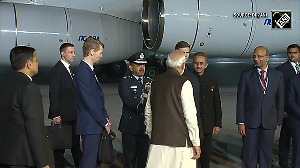Varying assessments of the massive increase in jobs in the United States on account of the expected trade in equipment were made. These projections went a long way in vetting the appetite of the industrial sector in the United States and in aggravating the suspicions in the non-proliferation lobbies.
The enthusiasm for the nuclear deal by the US-India Business Council (USIBC), consisting of the big players in India-US trade was attributed to the lure of nuclear trade with India. The USIBC engaged professional lobbyists in Washington to promote the deal on the Hill and elsewhere and there was considerable jubilation in it when the deal was signed.
In India too, the presumption was that significant nuclear trade with the US would follow the deal. Although experts knew that the US had no ready reactors to sell, it was believed that the US industry had already begun to fabricate reactors, using old technology to capture the Indian market.
The US insistence on strict regulations on nuclear trade and its reluctance to give assurances of perpetuity of supplies were seen as mere ploys to get the best business terms for nuclear trade. The argument was that the US would not sacrifice business opportunities for the sake of non-proliferation objectives.
Why should the US work so hard to secure Nuclear Suppliers Group (NSG) waiver for India merely to facilitate supply of reactors by Russia and France to India?
There were whispers in India during the negotiations that we should be Machiavellian in our approach to the United States. Some suggested that India should go along with the US conditions till we obtained the necessary clearances and then not place any orders in the US if the conditions of supply were not favourable to us.
The natural reaction of the US side was to extract a Memorandum of Understanding from India that we would seek to secure a significant percentage of our nuclear supplies from the US. It was also insisted on that India should earmark two locations for the installation of US reactors in India.
The Obama administration has maintained this position and one of the trophies that US Secretary of State Hillary Clinton carried back from India was an assurance on locations for American reactors.
But the latest indication from Washington is that the US may not be interested in supplying nuclear material and reactors to India under the new dispensation. This is emerging as a matter of policy as well as a practical measure. President Obama does not want to stand in the way of the implementation of the 123 Agreement, but he is sensitive to the criticism that he is willing to dilute his commitment to non-proliferation for the sake of commercial advantages.
He has, therefore, embarked on a path to do the minimum necessary to let the deal run its course without the US itself contributing to the growth of the nuclear strength of India. He wishes to remain committed to the universalisation of the NPT, while pursuing the vision of a nuclear weapon free world in the long term.
The Washington move in G-8 on enrichment and reprocessing should be seen in this context. While the discussions on reprocessing, as provided for in the 123 agreement, will proceed, supply of equipment and technology in the sensitive areas will be ruled out. The US will also work for a gradual revision of the NSG consensus to put sensitive technology beyond the reach of India and others.
Nor will there be iron glad guarantees of perpetuity of supplies. The US understands that an inevitable consequence of this strategy is that the US will not be able to supply any nuclear material to India at any time. This fact is being accepted as a reality and as a virtue. It will demonstrate to the world that the US is serious about its non-proliferation protestations.
The new men and women in charge of non-proliferation in Washington do believe that the nuclear deal is not in the interest of non-proliferation and they want to curb it to the extent possible without appearing to back off from it.
The US is also reconciled to Russia and France supplying fuel and equipment under the terms of the NSG waiver. It may not be averse to indirect participation in the French deals, if such opportunities arise, but it is gradually preparing the industry to close their options to open nuclear trade with India.
The compensation that the US expects is in terms of defence deals with India, which have as much potential, if not more, for job creation and overall growth in trade. The US has, therefore, been diligent about pursuing the end user agreement, without which defence deals would not be possible under the US laws.
The US had no doubt that this would be clinched as India had agreed to have similar agreements in the past. Compared to the legal rigmarole that the industry would face in the case of nuclear supplies, the defence formalities are not difficult to complete.
Defence supplies will meet the needs of a vibrant industrial complex, which cannot sustain without exports, while nuclear trade regulations in the US are too complicated to be tackled. The choice, therefore, is clear for the US policy makers.
As for India, no tears will be shed for loss of unreliable supplies from the US as long as the other suppliers keep their commitments.
The new strategy in the US will mean the emergence of tough choices for India in the years ahead. Once the US is out of any obsession with the attractions of nuclear trade with India, it will be more direct in pursuing its non-proliferation objectives with India.
When the Comprehensive Test Ban Treaty (CTBT) and the Fissile Material Cutoff Treaty (FMCT) are mature for ratification by India, the pressure on us will be very great indeed. There will be no industrial lobby to shield India at that time.
If the US is willing to give up its nuclear trade with India and the China factor is diminishing, what other factors will make it possible for the United States to sustain the deal?
Two theories have surfaced in recent days. One is a cynical view that the deal was just a lollipop offered to India to compensate for the massive supply of arms to Pakistan, which was already on the anvil during the Bush era.
India could hardly complain as the beneficiary of a waiver on nuclear matters when the US steps up military cooperation with Pakistan. This theory assumes that President Bush had the foresight to anticipate the Af-Pak crisis.
Another theory is that the real reason for the deal was that the US wanted a massive infusion of Indian nuclear technicians into the country in the next few years, when the US unveils its own plan to reduce dependence on foreign oil. By offering India the deal, the Bush administration was simply setting up a nursery of nuclear scientists, who could be transplanted to the US at the appropriate time. This may be far fetched, but the theory exists.
India must brace itself for a new round with the US, not only on the unfinished business of the nuclear deal, but also on the new dimensions emerging in the thinking of the Obama team.
T P Sreenivasan, a former member of the Indian Foreign Service, was India's ambassador to the United Nations, Vienna, and governor for India, International Atomic Energy Agency, Vienna.





